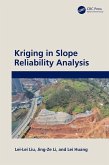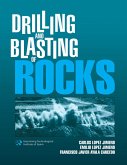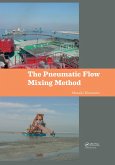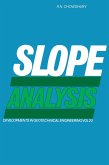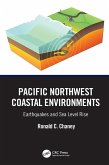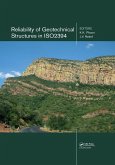

Alle Infos zum eBook verschenken

- Format: PDF
- Merkliste
- Auf die Merkliste
- Bewerten Bewerten
- Teilen
- Produkt teilen
- Produkterinnerung
- Produkterinnerung

Hier können Sie sich einloggen

Bitte loggen Sie sich zunächst in Ihr Kundenkonto ein oder registrieren Sie sich bei bücher.de, um das eBook-Abo tolino select nutzen zu können.
Kriging can be used to determine optimal unbiased predictions for regionalized variables and has been shown to be a powerful tool in slope reliability analysis for reliability-based design. This is the first book to systematically cover the basic theory and applications of the method in slope reliability assessment.
The book gives an extensive and detailed presentation of principles and applications, introducing geostatistics and the basic theory of Kriging before addressing the challenges in the application of Kriging in slope reliability analysis. The latest advancements in Kriging…mehr
- Geräte: PC
- mit Kopierschutz
- eBook Hilfe
![Kriging in Slope Reliability Analysis (eBook, ePUB) Kriging in Slope Reliability Analysis (eBook, ePUB)]() Lei-Lei LiuKriging in Slope Reliability Analysis (eBook, ePUB)52,95 €
Lei-Lei LiuKriging in Slope Reliability Analysis (eBook, ePUB)52,95 €![Drilling and Blasting of Rocks (eBook, PDF) Drilling and Blasting of Rocks (eBook, PDF)]() C. Lopez JimenoDrilling and Blasting of Rocks (eBook, PDF)225,95 €
C. Lopez JimenoDrilling and Blasting of Rocks (eBook, PDF)225,95 €![The Pneumatic Flow Mixing Method (eBook, PDF) The Pneumatic Flow Mixing Method (eBook, PDF)]() The Pneumatic Flow Mixing Method (eBook, PDF)48,95 €
The Pneumatic Flow Mixing Method (eBook, PDF)48,95 €![Slope Analysis (eBook, PDF) Slope Analysis (eBook, PDF)]() R. ChowdurySlope Analysis (eBook, PDF)40,95 €
R. ChowdurySlope Analysis (eBook, PDF)40,95 €![Pacific Northwest Coastal Environments (eBook, PDF) Pacific Northwest Coastal Environments (eBook, PDF)]() Ronald C. ChaneyPacific Northwest Coastal Environments (eBook, PDF)52,95 €
Ronald C. ChaneyPacific Northwest Coastal Environments (eBook, PDF)52,95 €![Reliability of Geotechnical Structures in ISO2394 (eBook, PDF) Reliability of Geotechnical Structures in ISO2394 (eBook, PDF)]() Reliability of Geotechnical Structures in ISO2394 (eBook, PDF)48,95 €
Reliability of Geotechnical Structures in ISO2394 (eBook, PDF)48,95 €![Multiple Scales of Suspended Sediment Dynamics in a Complex Geometry Estuary (eBook, PDF) Multiple Scales of Suspended Sediment Dynamics in a Complex Geometry Estuary (eBook, PDF)]() Fernanda AcheteMultiple Scales of Suspended Sediment Dynamics in a Complex Geometry Estuary (eBook, PDF)58,95 €
Fernanda AcheteMultiple Scales of Suspended Sediment Dynamics in a Complex Geometry Estuary (eBook, PDF)58,95 €-
-
-
The book gives an extensive and detailed presentation of principles and applications, introducing geostatistics and the basic theory of Kriging before addressing the challenges in the application of Kriging in slope reliability analysis. The latest advancements in Kriging application methods are introduced, which enhance computational accuracy and reduce model errors. These include optimization algorithms for spatial parameters in Kriging, adaptive modeling of spatial correlation structures, efficient sampling methods based on Monte Carlo simulation, quantitative analysis of slope failure risks, and reliability analysis methods for unreinforced and reinforced slopes based on conditional random fields. Several case studies are presented to illustrate the practical application and implementation procedures, bridging theory, and practical engineering.
Kriging in Slope Reliability Analysis particularly suits consulting engineers, researchers, and postgraduate students.
Dieser Download kann aus rechtlichen Gründen nur mit Rechnungsadresse in A, B, BG, CY, CZ, D, DK, EW, E, FIN, F, GR, HR, H, IRL, I, LT, L, LR, M, NL, PL, P, R, S, SLO, SK ausgeliefert werden.
- Produktdetails
- Verlag: Taylor & Francis eBooks
- Seitenzahl: 336
- Erscheinungstermin: 25. November 2024
- Englisch
- ISBN-13: 9781040172117
- Artikelnr.: 72287860
- Verlag: Taylor & Francis eBooks
- Seitenzahl: 336
- Erscheinungstermin: 25. November 2024
- Englisch
- ISBN-13: 9781040172117
- Artikelnr.: 72287860
- Herstellerkennzeichnung Die Herstellerinformationen sind derzeit nicht verfügbar.
Jing-Ze Li is a research associate at Central South University, China. His PhD research was undertaken jointly with Central South University, China and Université Grenoble Alpes, France.
Lei Huang is an associate professor at Sanming University, China. He received his PhD in The Hong Kong Polytechnic University.
example #1 53 5.3.4 Analytical validation of GATK
example #2 57 5.4 System reliability analysis using GATK surrogate model 59 5.5 Illustrative examples 59 5.5.1 A homogeneous c-
slope 60 5.5.2 A heterogeneous two-layered soil slope 64 5.6 Discussions 70 5.7 Conclusions 73 References 73 6 Adaptively selected-autocorrelation structure-based Kriging metamodel for slope reliability analysis 76 6.1 Introduction 76 6.2 The proposed GAWMK method 78 6.3 Implementation procedure of the proposed method for slope reliability analysis 80 6.4 Validation of the proposed method and the modified DACE toolbox 83 6.4.1 A one-dimensional cubic function 83 6.4.2 A three-dimensional data fitting problem 88 6.5 Applications to slope reliability analysis 90 6.5.1 Example 1: a homogeneous c-
slope 90 6.5.2 Example 2: a two-layered cohesive soil slope 96 6.5.3 Example 3: a three-layered cohesive soil slope 98 6.5.4 Example 4: a three-layered c-
slope 101 6.6 Summary and conclusions 102 References 104 7 System reliability analysis of soil slopes using an advanced Kriging metamodel and quasi Monte Carlo simulation 108 7.1 Introduction 108 7.2 Probabilistic analysis of soil slope stability using QMCS 111 7.3 Advanced Kriging metamodel 112 7.3.1 Genetic algorithm optimized Kriging 112 7.3.2 Construction of the advanced Kriging method 113 7.4 AKQMCS for system reliability analysis of soil slopes 116 7.5 Illustrative examples 119 7.5.1 Example #1: a two-layered cohesive slope 119 7.5.2 Example #2: a three-layered c-
slope 124 7.5.3 Example #3: a single-layered sand slope 129 7.6 Summary and conclusions 132 References 134 8 Efficient slope reliability analysis and risk assessment based on multiple Kriging surrogate models 138 8.1 Introduction 138 8.2 The proposed MK method for slope reliability analysis and risk assessment 140 8.2.1 General idea of MK method 140 8.2.2 Slope reliability analysis based on the proposed MK method 142 8.2.3 Slope risk assessment based on the proposed MK method 144 8.3 Implementation procedure of the proposed MK method 145 8.4 Illustrative examples 147 8.4.1 Example 1: a two-layered cohesive soil slope 148 8.4.2 Example 2: Congress Street cut slope 153 8.5 Discussions 158 8.6 Conclusions 160 References 161 9 A new active learning Kriging surrogate model for structural system reliability analysis with multiple failure modes 165 9.1 Introduction 165 9.2 The proposed ALK-SD method for system reliability analysis 167 9.2.1 Basic idea of ALK-SD 167 9.2.2 Identification of significant domain 169 9.2.3 Determination of ATSs 173 9.2.4 System reliability analysis based on ALK-SD 174 9.2.5 Implementation procedure 175 9.3 Numerical examples 177 9.3.1 Example 1: a series system with four branches 177 9.3.2 Example 2: a parallel system with three failure modes 181 9.3.3 Example 3: a series system with three failure modes 182 9.3.4 Example 4: a parallel system with disconnected failure regions 186 9.3.5 Example 5: a mass gravity retaining wall with five random variables 187 9.4 Discussion 192 9.4.1 The determination of
(
) 192 9.4.2 Comparison with other U-function series methods 194 9.4.3 Comparison of the computational efficiency and robustness 195 9.4.4 The locations of the ATSs 197 9.5 Conclusion 199 References 202 10 New Kriging methods for efficient system slope reliability analysis considering soil spatial variability 205 10.1 Introduction 205 10.2 Review of MK-based slope reliability analyses 208 10.3 The proposed new Kriging methods 208 10.3.1 Basic idea 208 10.3.2 RALK method 209 10.3.3 MK-RSS-SIR method 218 10.3.4 MK-RSS method 218 10.4 Example 1: a three-layered cohesive slope 218 10.4.1 Results of RALK method 220 10.4.2 Results of MK-RSS-SIR method 231 10.4.3 Results of MK-RSS method 234 10.5 Example 2: a four-layered slope with a soft band 236 10.5.1 Results of RALK method 239 10.5.2 Results of MK-RSS-SIR method 241 10.5.3 Results of MK-RSS method 243 10.6 Discussion 244 10.6.1 Comparison of the computational accuracy 244 10.6.2 Comparison of the computational efficiency 245 10.6.3 Slope types applicable to three methods 246 10.7 Summary and conclusions 247 References 249 11 Conditional random field reliability analysis of a cohesion-frictional slope 255 11.1 Introduction 255 11.2 Simulation of unconditional random field 257 11.3 Simulation of conditional random field 260 11.4 Probabilistic analysis of a slope based on SS 262 11.5 Implementation procedure of conditional probabilistic analysis 264 11.6 Illustrative example 267 11.6.1 Basic model 267 11.6.2 Reliability results based on unconditional random fields 268 11.6.3 Reliability results based on conditional random fields 270 11.7 Summary and conclusions 280 References 283 12 Reliability analysis and risk assessment of pile-reinforced slopes considering spatial soil variability and site investigation 286 12.1 Introduction 286 12.2 Simulation of soil spatial variability based on random field theory 288 12.2.1 Conditional random field 288 12.2.2 Conditional stationary random field based on investigation boreholes 289 12.3 Probabilistic analysis of pile-reinforced slope 291 12.3.1 Stability analysis of pile-reinforced slopes 291 12.3.2 RFDM for slope reliability analysis and risk assessment 294 12.4 Implementation procedure for the proposed framework 295 12.5 Illustrative example 297 12.5.1 Influence of investigation scheme on soil uncertainty 301 12.5.2 Influence of investigation scheme on probabilistic characteristics of slope safety 305 12.5.3 Influence of investigation scheme on slope failure probability and quantitative risk 311 12.5.4 Influence of investigation scheme on pile structural responses 313 12.6 Summary and conclusions 316 References 317 13 Summary and concluding remarks 321 Index 323
example #1 53 5.3.4 Analytical validation of GATK
example #2 57 5.4 System reliability analysis using GATK surrogate model 59 5.5 Illustrative examples 59 5.5.1 A homogeneous c-
slope 60 5.5.2 A heterogeneous two-layered soil slope 64 5.6 Discussions 70 5.7 Conclusions 73 References 73 6 Adaptively selected-autocorrelation structure-based Kriging metamodel for slope reliability analysis 76 6.1 Introduction 76 6.2 The proposed GAWMK method 78 6.3 Implementation procedure of the proposed method for slope reliability analysis 80 6.4 Validation of the proposed method and the modified DACE toolbox 83 6.4.1 A one-dimensional cubic function 83 6.4.2 A three-dimensional data fitting problem 88 6.5 Applications to slope reliability analysis 90 6.5.1 Example 1: a homogeneous c-
slope 90 6.5.2 Example 2: a two-layered cohesive soil slope 96 6.5.3 Example 3: a three-layered cohesive soil slope 98 6.5.4 Example 4: a three-layered c-
slope 101 6.6 Summary and conclusions 102 References 104 7 System reliability analysis of soil slopes using an advanced Kriging metamodel and quasi Monte Carlo simulation 108 7.1 Introduction 108 7.2 Probabilistic analysis of soil slope stability using QMCS 111 7.3 Advanced Kriging metamodel 112 7.3.1 Genetic algorithm optimized Kriging 112 7.3.2 Construction of the advanced Kriging method 113 7.4 AKQMCS for system reliability analysis of soil slopes 116 7.5 Illustrative examples 119 7.5.1 Example #1: a two-layered cohesive slope 119 7.5.2 Example #2: a three-layered c-
slope 124 7.5.3 Example #3: a single-layered sand slope 129 7.6 Summary and conclusions 132 References 134 8 Efficient slope reliability analysis and risk assessment based on multiple Kriging surrogate models 138 8.1 Introduction 138 8.2 The proposed MK method for slope reliability analysis and risk assessment 140 8.2.1 General idea of MK method 140 8.2.2 Slope reliability analysis based on the proposed MK method 142 8.2.3 Slope risk assessment based on the proposed MK method 144 8.3 Implementation procedure of the proposed MK method 145 8.4 Illustrative examples 147 8.4.1 Example 1: a two-layered cohesive soil slope 148 8.4.2 Example 2: Congress Street cut slope 153 8.5 Discussions 158 8.6 Conclusions 160 References 161 9 A new active learning Kriging surrogate model for structural system reliability analysis with multiple failure modes 165 9.1 Introduction 165 9.2 The proposed ALK-SD method for system reliability analysis 167 9.2.1 Basic idea of ALK-SD 167 9.2.2 Identification of significant domain 169 9.2.3 Determination of ATSs 173 9.2.4 System reliability analysis based on ALK-SD 174 9.2.5 Implementation procedure 175 9.3 Numerical examples 177 9.3.1 Example 1: a series system with four branches 177 9.3.2 Example 2: a parallel system with three failure modes 181 9.3.3 Example 3: a series system with three failure modes 182 9.3.4 Example 4: a parallel system with disconnected failure regions 186 9.3.5 Example 5: a mass gravity retaining wall with five random variables 187 9.4 Discussion 192 9.4.1 The determination of
(
) 192 9.4.2 Comparison with other U-function series methods 194 9.4.3 Comparison of the computational efficiency and robustness 195 9.4.4 The locations of the ATSs 197 9.5 Conclusion 199 References 202 10 New Kriging methods for efficient system slope reliability analysis considering soil spatial variability 205 10.1 Introduction 205 10.2 Review of MK-based slope reliability analyses 208 10.3 The proposed new Kriging methods 208 10.3.1 Basic idea 208 10.3.2 RALK method 209 10.3.3 MK-RSS-SIR method 218 10.3.4 MK-RSS method 218 10.4 Example 1: a three-layered cohesive slope 218 10.4.1 Results of RALK method 220 10.4.2 Results of MK-RSS-SIR method 231 10.4.3 Results of MK-RSS method 234 10.5 Example 2: a four-layered slope with a soft band 236 10.5.1 Results of RALK method 239 10.5.2 Results of MK-RSS-SIR method 241 10.5.3 Results of MK-RSS method 243 10.6 Discussion 244 10.6.1 Comparison of the computational accuracy 244 10.6.2 Comparison of the computational efficiency 245 10.6.3 Slope types applicable to three methods 246 10.7 Summary and conclusions 247 References 249 11 Conditional random field reliability analysis of a cohesion-frictional slope 255 11.1 Introduction 255 11.2 Simulation of unconditional random field 257 11.3 Simulation of conditional random field 260 11.4 Probabilistic analysis of a slope based on SS 262 11.5 Implementation procedure of conditional probabilistic analysis 264 11.6 Illustrative example 267 11.6.1 Basic model 267 11.6.2 Reliability results based on unconditional random fields 268 11.6.3 Reliability results based on conditional random fields 270 11.7 Summary and conclusions 280 References 283 12 Reliability analysis and risk assessment of pile-reinforced slopes considering spatial soil variability and site investigation 286 12.1 Introduction 286 12.2 Simulation of soil spatial variability based on random field theory 288 12.2.1 Conditional random field 288 12.2.2 Conditional stationary random field based on investigation boreholes 289 12.3 Probabilistic analysis of pile-reinforced slope 291 12.3.1 Stability analysis of pile-reinforced slopes 291 12.3.2 RFDM for slope reliability analysis and risk assessment 294 12.4 Implementation procedure for the proposed framework 295 12.5 Illustrative example 297 12.5.1 Influence of investigation scheme on soil uncertainty 301 12.5.2 Influence of investigation scheme on probabilistic characteristics of slope safety 305 12.5.3 Influence of investigation scheme on slope failure probability and quantitative risk 311 12.5.4 Influence of investigation scheme on pile structural responses 313 12.6 Summary and conclusions 316 References 317 13 Summary and concluding remarks 321 Index 323

